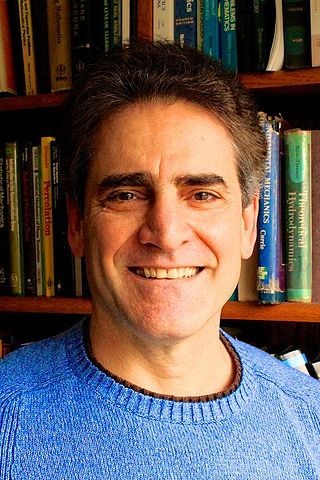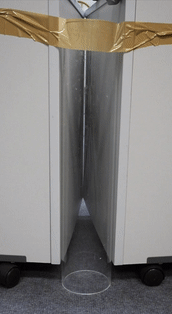
In geometry, the rhombicuboctahedron, or small rhombicuboctahedron or Rectified Rhombic Dodecahedron, is a polyhedron with eight triangular, six square, and twelve rectangular faces. There are 24 identical vertices, with one triangle, one square, and two rectangles meeting at each one. If all the rectangles are themselves square, it is an Archimedean solid. The polyhedron has octahedral symmetry, like the cube and octahedron. Its dual is called the deltoidal icositetrahedron or trapezoidal icositetrahedron, although its faces are not really true trapezoids.

In crystallography, crystal structure is a description of the ordered arrangement of atoms, ions, or molecules in a crystalline material. Ordered structures occur from the intrinsic nature of the constituent particles to form symmetric patterns that repeat along the principal directions of three-dimensional space in matter.

Packing problems are a class of optimization problems in mathematics that involve attempting to pack objects together into containers. The goal is to either pack a single container as densely as possible or pack all objects using as few containers as possible. Many of these problems can be related to real-life packaging, storage and transportation issues. Each packing problem has a dual covering problem, which asks how many of the same objects are required to completely cover every region of the container, where objects are allowed to overlap.

In geometry, the golden angle is the smaller of the two angles created by sectioning the circumference of a circle according to the golden ratio; that is, into two arcs such that the ratio of the length of the smaller arc to the length of the larger arc is the same as the ratio of the length of the larger arc to the full circumference of the circle.

A polaron is a quasiparticle used in condensed matter physics to understand the interactions between electrons and atoms in a solid material. The polaron concept was proposed by Lev Landau in 1933 and Solomon Pekar in 1946 to describe an electron moving in a dielectric crystal where the atoms displace from their equilibrium positions to effectively screen the charge of an electron, known as a phonon cloud. This lowers the electron mobility and increases the electron's effective mass.

In geometry, a rhombic enneacontahedron is a polyhedron composed of 90 rhombic faces; with three, five, or six rhombi meeting at each vertex. It has 60 broad rhombi and 30 slim. The rhombic enneacontahedron is a zonohedron with a superficial resemblance to the rhombic triacontahedron.
Tensor–vector–scalar gravity (TeVeS), developed by Jacob Bekenstein in 2004, is a relativistic generalization of Mordehai Milgrom's Modified Newtonian dynamics (MOND) paradigm.
The percolation threshold is a mathematical concept in percolation theory that describes the formation of long-range connectivity in random systems. Below the threshold a giant connected component does not exist; while above it, there exists a giant component of the order of system size. In engineering and coffee making, percolation represents the flow of fluids through porous media, but in the mathematics and physics worlds it generally refers to simplified lattice models of random systems or networks (graphs), and the nature of the connectivity in them. The percolation threshold is the critical value of the occupation probability p, or more generally a critical surface for a group of parameters p1, p2, ..., such that infinite connectivity (percolation) first occurs.
Random close packing (RCP) of spheres is an empirical parameter used to characterize the maximum volume fraction of solid objects obtained when they are packed randomly. For example, when a solid container is filled with grain, shaking the container will reduce the volume taken up by the objects, thus allowing more grain to be added to the container. In other words, shaking increases the density of packed objects. But shaking cannot increase the density indefinitely, a limit is reached, and if this is reached without obvious packing into an ordered structure, such as a regular crystal lattice, this is the empirical random close-packed density for this particular procedure of packing. The random close packing is the highest possible volume fraction out of all possible packing procedures.

In geometry, circle packing is the study of the arrangement of circles on a given surface such that no overlapping occurs and so that no circle can be enlarged without creating an overlap. The associated packing density, η, of an arrangement is the proportion of the surface covered by the circles. Generalisations can be made to higher dimensions – this is called sphere packing, which usually deals only with identical spheres.

In geometry, tetrahedron packing is the problem of arranging identical regular tetrahedra throughout three-dimensional space so as to fill the maximum possible fraction of space.
Type-1.5 superconductors are multicomponent superconductors characterized by two or more coherence lengths, at least one of which is shorter than the magnetic field penetration length , and at least one of which is longer. This is in contrast to single-component superconductors, where there is only one coherence length and the superconductor is necessarily either type 1 or type 2. When placed in magnetic field, type-1.5 superconductors should form quantum vortices: magnetic-flux-carrying excitations. They allow magnetic field to pass through superconductors due to a vortex-like circulation of superconducting particles. In type-1.5 superconductors these vortices have long-range attractive, short-range repulsive interaction. As a consequence a type-1.5 superconductor in a magnetic field can form a phase separation into domains with expelled magnetic field and clusters of quantum vortices which are bound together by attractive intervortex forces. The domains of the Meissner state retain the two-component superconductivity, while in the vortex clusters one of the superconducting components is suppressed. Thus such materials should allow coexistence of various properties of type-I and type-II superconductors.
The distance of closest approach of two objects is the distance between their centers when they are externally tangent. The objects may be geometric shapes or physical particles with well-defined boundaries. The distance of closest approach is sometimes referred to as the contact distance.
In polymer chemistry and polymer physics, the Flory–Fox equation is a simple empirical formula that relates molecular weight to the glass transition temperature of a polymer system. The equation was first proposed in 1950 by Paul J. Flory and Thomas G. Fox while at Cornell University. Their work on the subject overturned the previously held theory that the glass transition temperature was the temperature at which viscosity reached a maximum. Instead, they demonstrated that the glass transition temperature is the temperature at which the free space available for molecular motions achieved a minimum value. While its accuracy is usually limited to samples of narrow range molecular weight distributions, it serves as a good starting point for more complex structure-property relationships.

Salvatore Torquato is an American theoretical scientist born in Falerna, Italy. His research work has impacted a variety of fields, including physics, chemistry, applied and pure mathematics, materials science, engineering, and biological physics. He is the Lewis Bernard Professor of Natural Sciences in the Department of Chemistry and Princeton Institute for the Science and Technology of Materials at Princeton University. He has been a Senior Faculty Fellow in the Princeton Center for Theoretical Science, an enterprise dedicated to exploring frontiers across the theoretical natural sciences. He is also an Associated Faculty Member in three departments or programs at Princeton University: Physics, Program in Applied and Computational Mathematics, and Mechanical & Aerospace Engineering. On multiple occasions, he was a Member of the School of Mathematics as well as the School of Natural Sciences at the Institute for Advanced Study, Princeton, New Jersey.
In quantum mechanics, the cat state, named after Schrödinger's cat, is a quantum state composed of two diametrically opposed conditions at the same time, such as the possibilities that a cat is alive and dead at the same time.

Sphere packing in a cylinder is a three-dimensional packing problem with the objective of packing a given number of identical spheres inside a cylinder of specified diameter and length. For cylinders with diameters on the same order of magnitude as the spheres, such packings result in what are called columnar structures.
In quantum physics, the "monogamy" of quantum entanglement refers to the fundamental property that it cannot be freely shared between arbitrarily many parties.
The linearized augmented-plane-wave method (LAPW) is an implementation of Kohn-Sham density functional theory (DFT) adapted to periodic materials. It typically goes along with the treatment of both valence and core electrons on the same footing in the context of DFT and the treatment of the full potential and charge density without any shape approximation. This is often referred to as the all-electron full-potential linearized augmented-plane-wave method (FLAPW). It does not rely on the pseudopotential approximation and employs a systematically extendable basis set. These features make it one of the most precise implementations of DFT, applicable to all crystalline materials, regardless of their chemical composition. It can be used as a reference for evaluating other approaches.

Near-field radiative heat transfer (NFRHT) is a branch of radiative heat transfer which deals with situations for which the objects and/or distances separating objects are comparable or smaller in scale or to the dominant wavelength of thermal radiation exchanging thermal energy. In this regime, the assumptions of geometrical optics inherent to classical radiative heat transfer are not valid and the effects of diffraction, interference, and tunneling of electromagentic waves can dominate the net heat transfer. These "near-field effects" can result in heat transfer rates exceeding the blackbody limit of classical radiative heat transfer.














